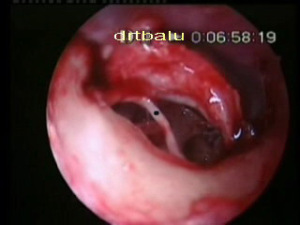Golding Wood operation
It is also known as Tympanic neurectomy.This procedure is performed to decrease salivary flow by interrupting parasympathetic fibers of Jacobson's nerve. It was first performed by Golding Wood hence goes by the term “Golding Wood operation”.
Indication:
1. In excessive drooling caused by neurological disorders
2. Frey syndrome following parotid surgery
3. Recurrent inflammation of parotid gland if conventional medical management fails
Procedure:
Can be performed both under local / General anesthesia.Postero superior tympanomeatal flap is created and carried down up to the level of annulus. The incision should be fashioned in such a way that if need arises it can be extended anteriorly along the inferior canal wall to about 5 o clock position. This extension of incision helps in the evaluation of the inferior most portion of the nerve as it enters through the floor of hypotympanum.
The annulus is dissected off its groove and is pushed forwards to 5 o clock position anteriorly and superiorly up to the short process of malleus. After elevation of the tympanic membrane the jacobson's nerve is identified at the promontory as it crosses from inferior to superior direction. This nerve may be completely exposed or partially covered by bone. The hypotympanic portion of this nerve is searched for its antero inferior branch which should be sought and avulsed. This nerve identified at the promontory should be cleared off its bony covering if present and avulsed completely.Even though majority of parasympathetic nerve supply to the parotid is via the tympanic nerve, it has been demonstrated that chorda tympani nerve also carries a few parasympathetic fibers.The decision to avulse chorda tympanic nerve along with Jacobson's nerve is highly controversial as it can lead to troublesome xerostomia.
Complications:
1. Residual perforation of ear drum
2. Damage to middle ear structures
3. Rarely troublesome xerostomia
